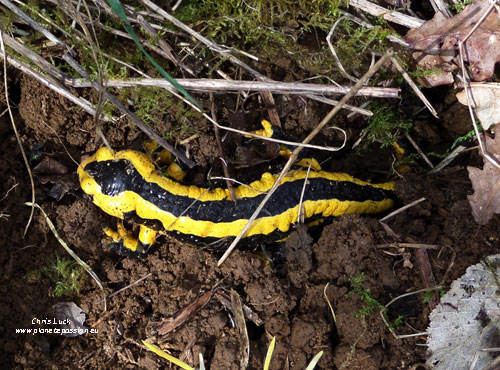
Fire Salamander Salamandra salamandra Salamandre Tachetée
The fire salamander is a large urodele that can grow up to 28cm in length with a wide head, thick strong legs, non webbed digits and a thick cylindrical tail which is rounded at the end. Colour can be extremely variable, possibly connected to habitat. There are three different sub species that are present in France, S. salamandra terrestris being the most common all over the country, S. salamandra.salamandra can be found in the extreme south east and S. salmandra.fastuosa in the Pyrenees. In general the colour is brilliant black marked with brilliant yellow or sometimes orange.

Above - Fire Salamander France
It can be found almost everywhere in France and is essentially a creature of woodlands where it lives in fallen leaves, dense moss and other debris and where there is a proximity to water. It is absent or rare in forests that are exclusively conifer, alluvial plains and areas where the soil is sandy in character such as coastal dunes. The food of the adults is made up of earthworms, insects and their larvae, slugs and other invertebrates to be found in the ground debris, whereas the larva are more opportunistic and voracious, eating various aquatic invertebrates including their own species. They are exclusively nocturnal spending the day under an old tree stump, in a stone wall or any other dark cavity, rainfall brings them out in large numbers and being both slow moving in combination with a tendency to stay completely still they have a high road accident rate.
Hibernation, if it takes place, is between October and March but is dependent on temperature and in milder winters or regions they can remain active throughout the year, hibernation can be in any underground cavity and large numbers of individuals can be found sharing the same place, up to 50 or more has been recorded. Their skin exudes a toxic substance which can burn sensitive skin and care should be taken not to touch your mouth if you have handled one. Should you need to handle one remember to wash your hands as soon as is practicable.
Reproduction which takes place
almost exclusively on land can take place anytime from spring until autumn
with late spring/early summer being favoured. The male rubs the female with
his nose and then slides under her so that she is on his back, they can stay
like this for quite a long period while he rubs her under the chin with his
head and rubs her cloaca with his tail, then when she is ready he releases
his spermatophore, which is a small slightly rigid packet of sperm which
also contains some nutrients which he places on the females cloaca where she
can receive it. The female can store this for several months before
fertilisation takes place internally and a period of gestation follows of
between 2 to 5 months. The young develop inside the female (Ovoviviparous)
and when they are ready to be released the female finds some water, this can
be almost anything, a ditch, pond, canal or even deep ruts left by vehicles
in mud, the young are then released, sometimes over a period of days, in
their small soft transparent sacs which open just before or just after
release into the water. This can occur anytime between October and April. At this time they are in a larval stage, with
external breathing organs for living in water, metamorphosis takes 3 to 5
months before they are able to live on land. Identification at this stage is
made easy by the small white or light mark where each leg joins the body.




Although seemingly common in most of France there has been a decline in numbers, a situation which is more pronounced in north east France, Belgium, Luxembourg and Germany.




